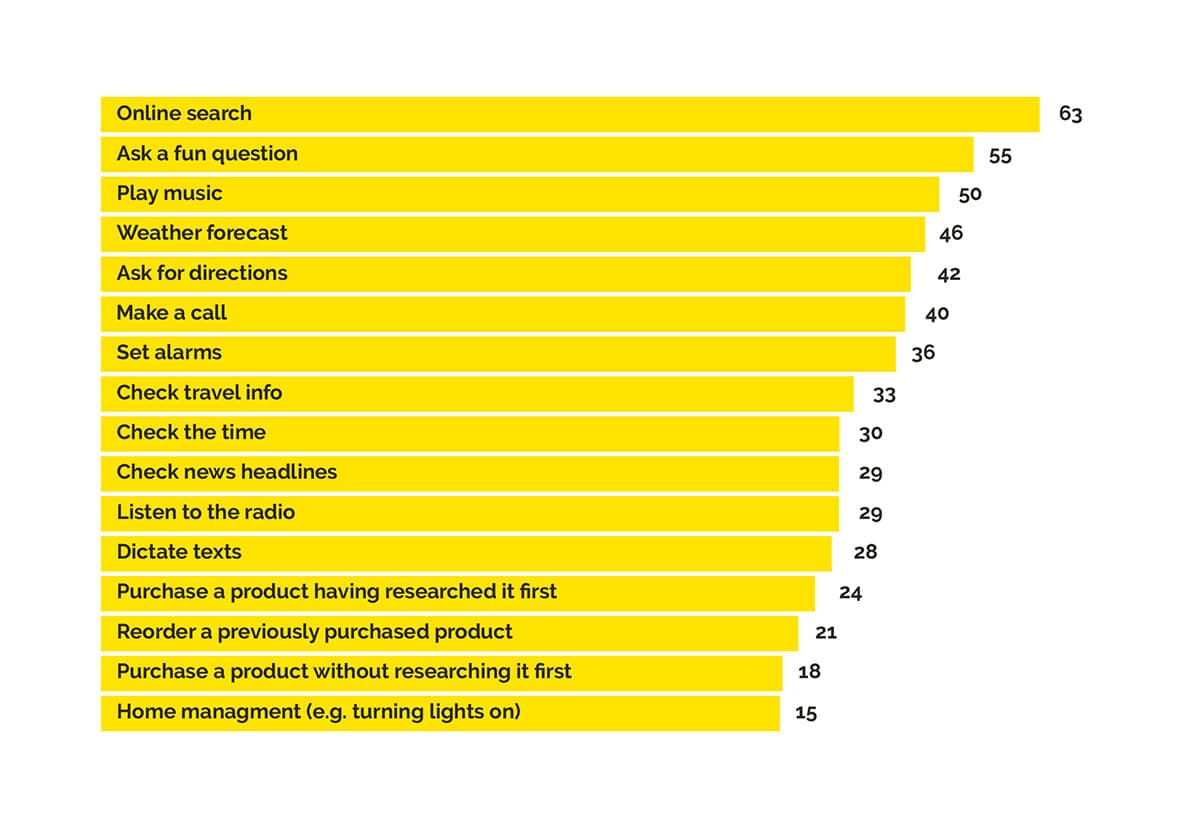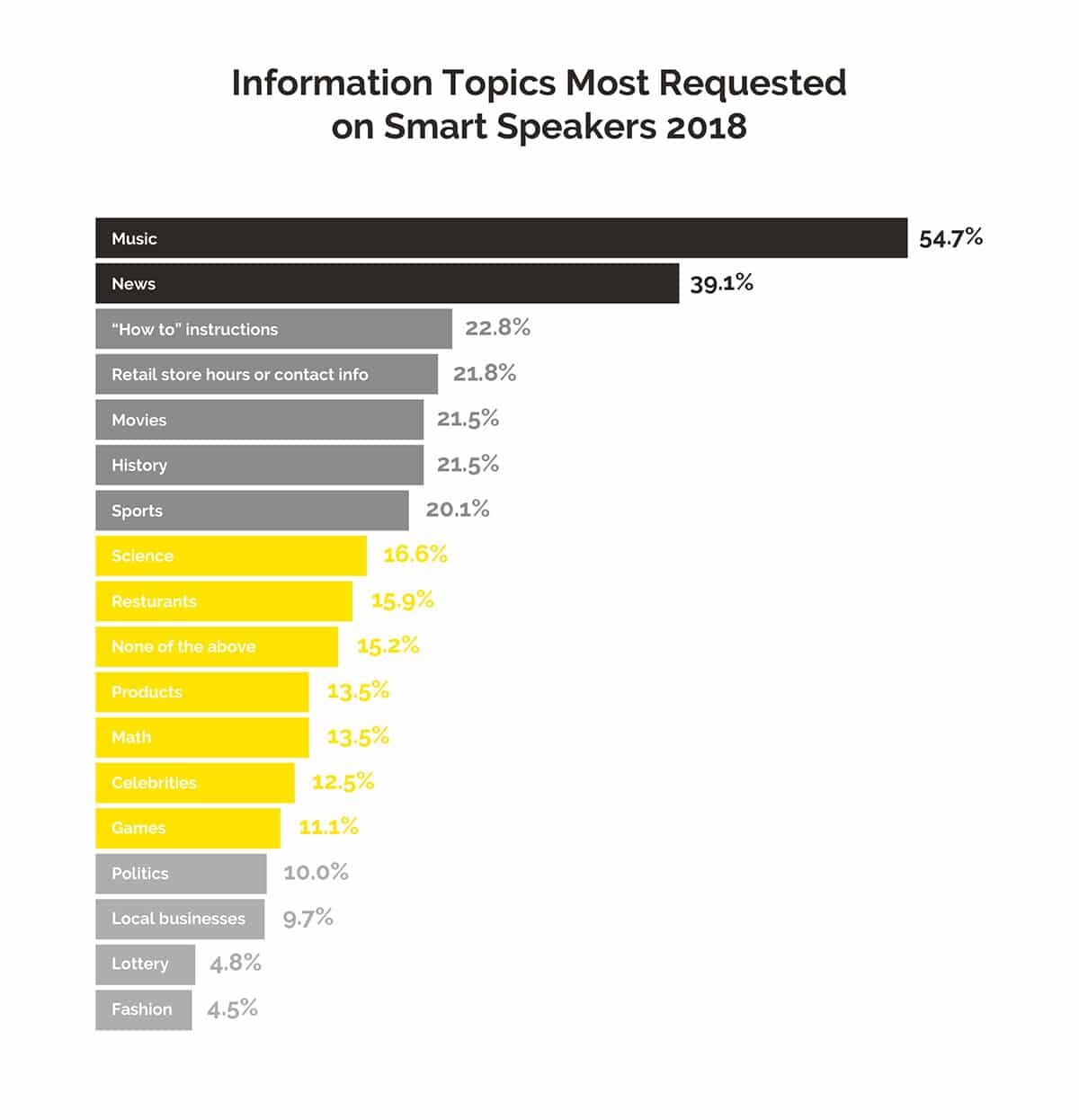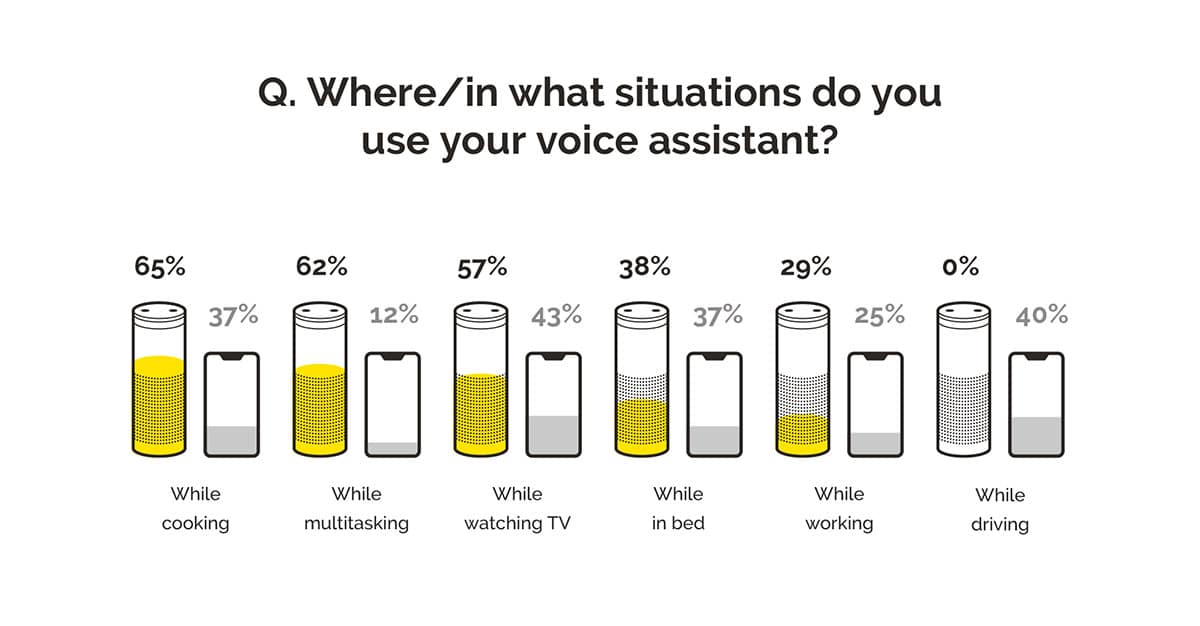New user behaviour surrounding voice search creates new opportunities for brands
Voice is designed to take the friction out of logging on to a computer and typing in a search enquiry or locating the right app on a mobile packed with icons for various apps.
As such, much of its current use is focused on instant gratification. A smartphone or smart speaker owner issues a command or asks a question and expects to be answered immediately.
Three categories of voice search use
That means right now people are saying ‘Alexa, play some Rolling Stones’ or ‘Alexa, set a timer for 15 minutes’, or perhaps asking the google voice search assistant, ‘Hey Google, what were the football results this weekend?’ or ‘Hey Google, order some dog food.’
Looking at these questions, we can break down voice activity into three categories:
- Knowledge Enquiries – These are the how, where, when, what questions that millions of people type into search engines every day. ‘How do I poach an egg?’ ‘Where is my nearest breakfast café?’ etc.
- Core Functions – These are predominantly practical actions and include setting a timer, playing music or controlling other appliances/systems like lighting or heating.
- Transactions – This can range from a one-off purchase or reordering an item, to setting up an account or sending a form.
These three categories aren’t distinct and don’t necessarily operate independently of each other. For example, Knowledge Enquiries can often lead to Transactions. E.g. ‘Hey Google, what is the best brand of dog food for small terriers?’ Google then returns an answer based on a featured snippet. The user can then follow up with ‘Hey Google, purchase X amount of TeenyTinyBowBow Food.’
Because of these complicated user journeys, identifying trends based on voice search statistics and industry reports can be rather difficult. As the graph below shows, e-commerce does not yet feature as a significant proportion of regular enquiries, other than to find out store opening hours (21%) and information about products (13%).
However, this only really relates what’s happening in the Knowledge Enquiries (Information Topics) category, not the Transactions category. Another report tells us that actually, 1 in 4 regularly make purchases on their voice app. So, what’s the deal? Well, it boils down to human behaviour and how we interact with media in our day-to-day lives. Establishing how people use media behind closed doors is one of the most difficult activities to quantify and measure. However, unsurprisingly, that’s not going to stop marketers from trying to paint a picture.
User behaviour
So, how come only a few people are making e-commerce enquiries but lots of people are purchasing things through voice search? The answer boils down to trust. Let’s talk about two products, dog food and a new sweater. When it comes to dog food, I know what my dog likes and how much food I need, and if it isn’t available, then I’m relatively happy to move to another brand and order through my voice search app. A sweater, however, is an expensive item, one of thousands I could choose from, and that choice relies heavily on my personal style and body shape etc. Essentially, there are too many variables in that purchasing journey. When I choose a sweater, I’d want to do my research e.g. establish typical size variations, make sure blue means blue and not light green etc.
And so, it starts to become clear that for marketers, the categories of voice functionality can be seen as a spectrum and need to be approached in a unique way. For Knowledge Enquiries, marketers are trying to get their content into the top slot, the knowledge box, so whatever information is read out is attached to their brand. However, the burning question most marketers want to know is, when are people going to trust voice functionality enough to move away from asking questions, setting alarms and playing music to making transactions?
Alexa Skills and Google Actions
The answer to that question comes in the form of Amazon and Google’s app creation software. This allows brands to create mini-apps that essentially help the user reduce the number of steps in their transaction journey. This can happen in a number of ways. Some voice skills allow users to reorder their standard shopping items or takeaway order. Others allow them to listen to their insurance details and communicate with the company through voice. Well-established skills manage a subscription music services. In this way, Alexa Skills and Google Actions bring Transaction activity closer to the Core Functions, reducing the friction in engaging with brands. As you can see from the graph below which outlines the most common uses of voice apps, the most common uses are Knowledge Enquiries, followed by Core Functions, and Transactions at the bottom. By turning Transactions into Core Functions, brands can remove the friction that obstructs users from purchasing products, using services and managaing subscriptions.

Identifying trends:
Brands are starting to take notice; one of the world’s biggest advertising agencies claims we are experiencing the early days of a voice commerce revolution.
Before rebranding to Wunderman Thompson, advertising giant JWT published its Speak Easy report on how voice is being used by consumers. The major finding around voice commerce backs up most marketers’ gut feeling. While 18% of regular voice search users have bought a product via voice without any prior research, 24% have done so after conducting research elsewhere.
The JWT researchers concluded that non-screen voice purchases are primarily being driven by repeat orders of everyday household goods that require no research. Hence talking to Alexa is the equivalent of a shortcut to an ‘order again’ button.
Brands can tap into the hands-free trend
JWT also points out that voice search functionality is changing our behaviour. Voice allows users to multitask in a way that wasn’t previously possible and that in itself is creating a number of new behaviours, such as asking for a ‘flash briefing’ (a review of the day’s headlines) while getting ready in the morning, requesting a radio station be played while making breakfast or asking for directions while driving to a meeting.
Cooking or bathing the kids are two examples offered by JWT’s researchers. Both the activities offer new ways through which brands can engage with customers. For example, a spice brand can propose ingredients and add them to shopping lists during a cooking lesson. Or a children’s shampoo brand might create a skill that reads pirate stories or plays sounds of the sea during bath time, thereby raising or reinforcing brand awareness and encouraging future purchases.
New contexts build new opportunities
These new behaviours are going to prove of great interest to brands as people make purchases while occupied with another task.
PwC looked a little at the context of how new selling and branding opportunities are opening up.
Smart speaker use is being driven by people who have their hands full multi-tasking, particularly in the kitchen. And while people talk about second-screening, talking to one’s smart speaker while watching television is even more prevalent than talking to one’s phone.
So, very nearly one in four people are repeat-ordering via voice and nearly one in five are buying products they have not yet fully researched online. Clearly, the voice commerce revolution is developing, although how far beyond Amazon this is currently spreading has yet been quantified.
The important thing brands need to realise is that voice is changing behaviour and this is being driven by owners who will typically be multi-tasking. These new moments of cooking dinner, bathing the kids, setting an alarm at bedtime and second screening (or rather second ‘speakering’) are the new friction-free frontier in the battle brands wage to raise awareness and drive sales.



